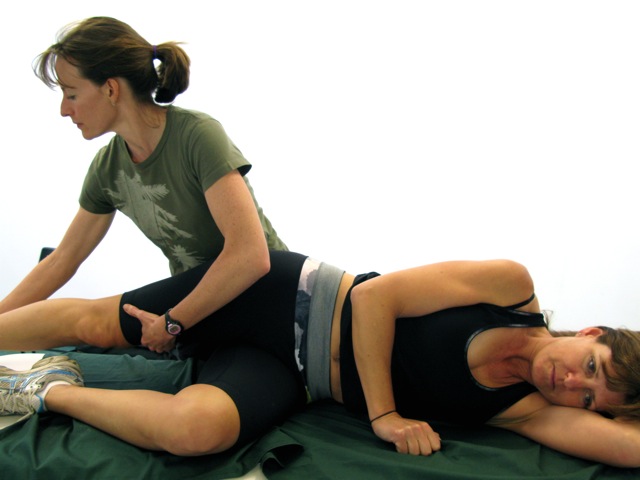Upper Half of Body and Lower Extremities
Have a look at what we will be covering during this workshop…
Trigger Point theory.
- Causes of trigger point formation
- Trigger points refer pain in predictable patterns
- Trigger points affect muscle, fascia and ligaments
- Other symptoms that trigger points produce (e.g. autonomic/proprioceptive phenomena)
- Susceptibility to trigger points
- Vitamins and minerals; their relationship to muscle health
- How to carry out basic “trigger points” assessment of your client
- How to physically train/rehab the client when trigger points are suspected
- The Trigger Point Therapy Workbook: by Clair Davies, N.C.T.M.B.
- Travell and Simons, M.D. and their contributions to Trigger Point
TMJD and Related Issues.
- Practicing location/palpation techniques on sternocleidomastoid, levator scapula, masseter* , temporalis, lateral pterygoid*, medial pterygoid, digastric, pectoralis, and trapezius muscles.
(*NCBTMB workshops – external palpation only)
Treating Headaches, Neck Pain, Vertigo, and Migraine.
- detailed palpation techniques of muscles for trigger points, treatment techniques, post-treatment protocol, latent/active TrPs, contraindications.
- explain how TrPs play a major role in vertigo, neck pain, headache issues and migraine.
- discuss the muscles that play a causal role in these issues – and how to deactivate their trigger points.
- Some muscles we will treat are: sternocleidomastoid, suboccipital, trapezius, temporalis, and others.
- demonstrate how exercise affects trigger points in these muscles.
- protocol for rehabilitating the TrP affected muscle.
- how TrPs always affect muscle strength and performance and why muscle performance always improves when trigger points are removed.
- the effects of heat/ice on TrPs.
- how stress, medications, over-use, trauma and skeletal abnormalities affect TrPs.
Arm Pain, CTS, Tennis/Golfer’s Elbow, Hand Pain/Numbness.
- detailed palpation techniques of muscles for trigger points, treatment techniques, post-treatment protocol, latent/active TrPs, contraindications.
- explain how TrPs play a major role in arm pain, CTS, tennis/golfer’s elbow, hand pain/numbness.
- discuss the muscles that play a causal role in these issues – and how to deactivate their trigger points.
- Some muscles we will treat are: triceps, scalenes, biceps, hand extensors/flexors and others.
- demonstrate how exercise affects trigger points in these muscles.
- protocol for rehabilitating the TrP affected muscle.
- how stress, medications, over-use, trauma and skeletal abnormalities affect TrPs.
Chest Pain, Breast Pain, and Upper Back Pain.
- detailed palpation techniques of muscles for trigger points, treatment techniques, post-treatment protocol, latent/active TrPs, contraindications.
- explain how TrPs play a major role in chest pain, breast pain, and upper back pain.
- discuss the muscles that play a causal role in these issues – and how to deactivate their trigger points.
- Some muscles we will treat are: pectoralis major/minor, serratus anterior, serratus posterior superior, scalenes, rhomboids, and others.
- demonstrate how exercise affects trigger points in these muscles.
- protocol for rehabilitating the TrP affected muscle.
- how stress, medications, over-use, trauma and skeletal abnormalities affect TrPs.
Lumbar, Hip, Buttock, and Groin Issues.
- detailed palpation techniques of muscles for trigger points, treatment techniques, post-treatment protocol, latent/active TrPs, contraindications.
- explain how TrPs play a major role in lumbar pain, hips, buttocks, and groin issues.
- discuss the muscles that play a causal role in these issues – and how to deactivate their trigger points.
- Some muscles we will treat are: gluteus maximus/medius/minimus, quadratus lumborum, erector spinae, piriformis, iliopsoas*, rectus abdominis* and others.
- demonstrate how exercise affects trigger points in these muscles.
- protocol for rehabilitating the TrP affected muscle.
- how stress, medications, over-use, trauma and skeletal abnormalities affect TrPs.
* NCBTMB workshops will only include treating TrPs in the abdominal area between the ASIS and lower ribs.
Bladder, IBS, Genital Pain, Dysmenorrhea, Abdominal, and Autonomic/Proprioceptive phenomena Issues.
- detailed palpation techniques of muscles for trigger points, treatment techniques, post-treatment protocol, latent/active TrPs, contraindications.
- explain how TrPs play a major role in bladder*, IBS*, genital pain*, dysmenorrhea*, and abdominal* and autonomic phenomena issues.
- discuss the muscles that play a causal role in these issues – and discuss how to deactivate their trigger points.
- Some muscles we will treat are: abdominal obliques, rectus abdominis, adductor magnus/ longus/ brevis**, pectoralis major and sternocleidomastoid.
- demonstrate how exercise affects trigger points in these muscles.
- protocol for rehabilitating the TrP affected muscle.
- how stress, over-use, trauma and skeletal abnormalities affect TrPs.
* NCBTMB workshops will only include treating TrPs in the abdominal area above ASIS.
** NCBTMB workshops will only include treating TrPs in the distal 2/3 of the thigh.
Thigh, (includes hamstring issues) Knees, Legs and Feet.
This will include sciatic pain, plantar fasciitis, heel spurs, and shin splints and Morton’s foot structure.
- detailed palpation techniques of muscles for trigger points, treatment techniques, post-treatment protocol, latent/active TrPs, contraindications.
- explain how TrPs play a major role in thigh, knees, legs and feet; this will include sciatic pain, plantar fasciitis, heel spurs, and shin splints.
- discuss the muscles that play a causal role in these issues – and how to deactivate their trigger points.
- Some muscles we will treat are: biceps femoris, semitendinosis, semimembranosus, hip adductors, quadriceps, extrinsic/intrinsic foot muscles.
- demonstrate how exercise affects trigger points in these muscles.
- protocol for rehabilitating the TrP affected muscle.
- how stress, over-use, trauma and skeletal abnormalities affect TrPs.
Questions/Summary/Certificates/Evaluations


